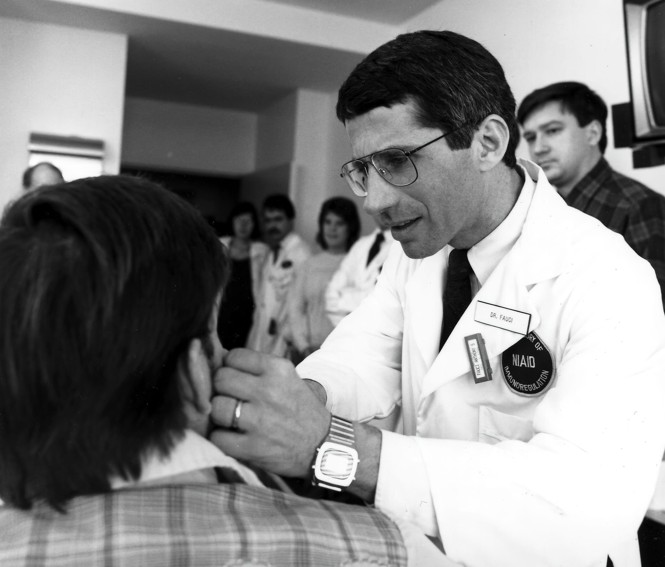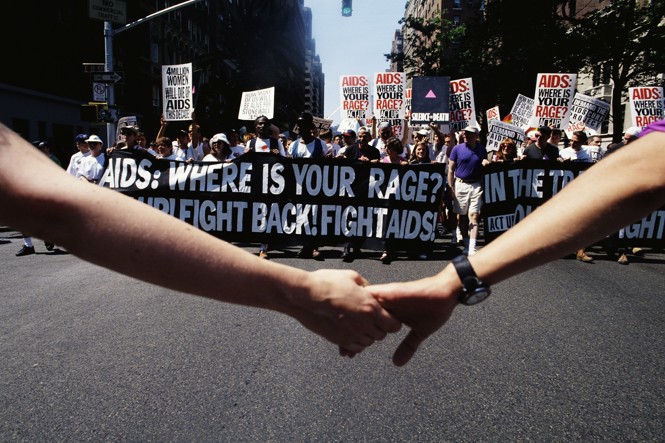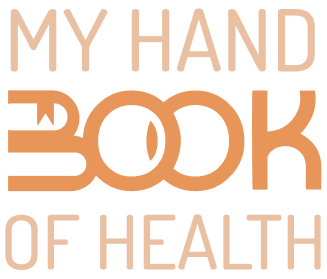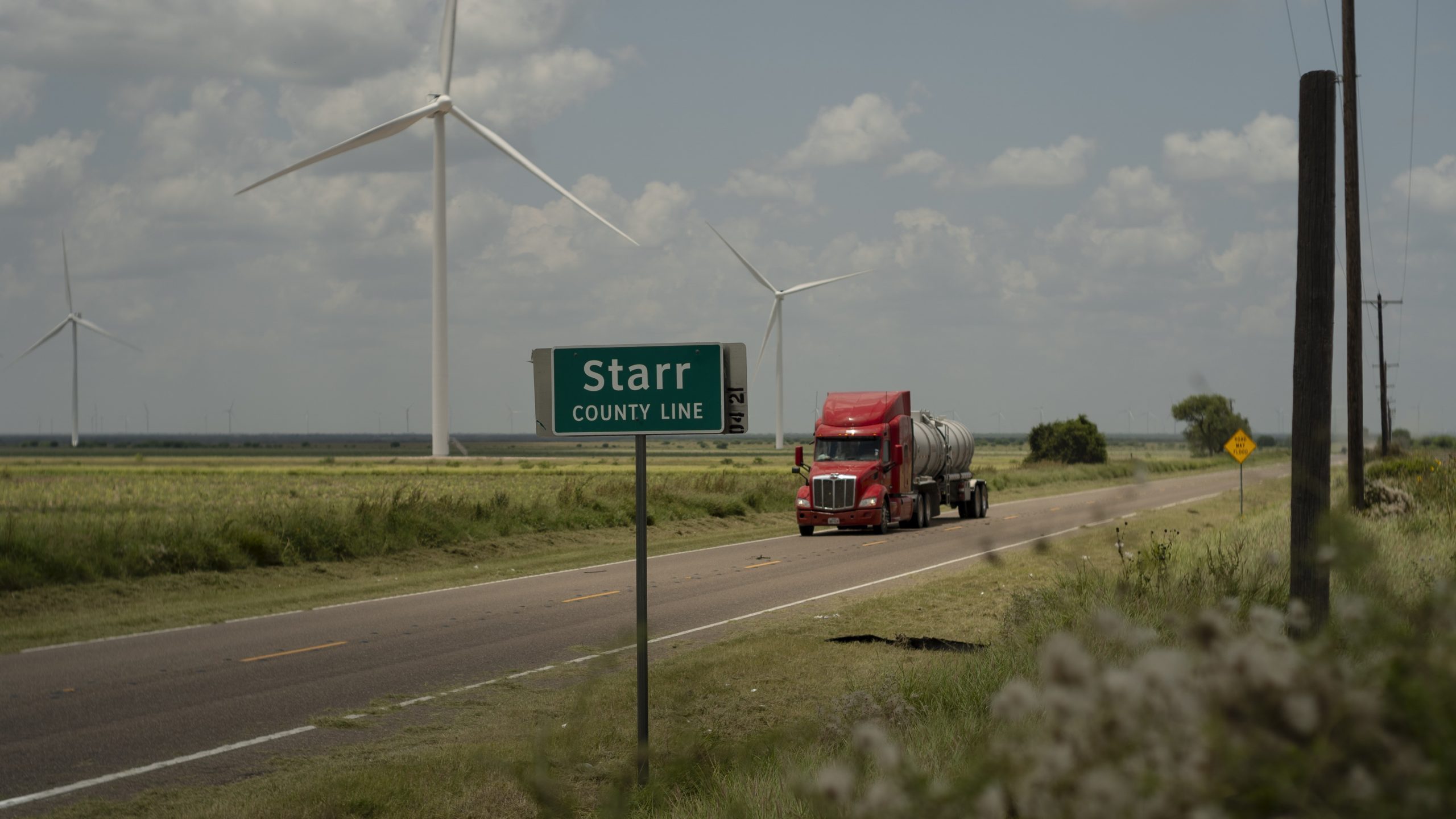If the United States learned any lesson from HIV, it should have been that negligence can be a death sentence. In the early 1980s, the virus’s ravages were treated as “something that happens over there, only to those people,” Juan Michael Porter II, a health journalist and an HIV activist, told me. But the more the virus and the people it most affected were ignored, the worse the epidemic got.
Reckoning with that reality changed the course of the HIV epidemic—and transformed how American public health was practiced. AIDS forced public-health officials to confront how stigma can speed disease; it emphasized that not just mandated tests and quarantines but education, engagement, and community partnership could dampen transmission. It showed how activism could challenge and advance science—and how focusing care on vulnerable populations, domestically and abroad, was key to stopping a disease’s spread.
The Trump administration is now tearing down that legacy. It has cut funding and programs for HIV research, treatment, and prevention so deeply that “we’re watching the field burn to the ground,” Rebecca Fielding-Miller, a behavioral scientist and an HIV researcher at UC San Diego, told me. In doing so, it is also razing the foundational public-health principles that HIV work laid.
Just six years ago, President Donald Trump’s first administration declared its commitment to end HIV in the U.S. by 2030, by funneling more resources into at-risk communities—an initiative that, over the past few years, has successfully reduced new infections. When reached for comment this week, a White House spokesperson told me that “the fight to end the HIV/AIDS epidemic will continue” and that by centralizing work on HIV/AIDS under the newly created Administration for a Healthy America, the Department of Health and Human Services “will be better positioned to end this epidemic by 2030, which is a priority for this Administration.”
But researchers and activists described the president’s recent actions as a clear about-face—and potentially petty, if not outright vindictive. Trump and his allies have soured on fighting infectious diseases generally—and on the public-health establishment that came up during the peak of the AIDS era and then helped define the nation’s COVID response. Several researchers told me they suspected that the administration’s attacks on infectious-disease research have been partially driven by the president’s distaste for Anthony Fauci, who led the National Institutes of Allergy and Infectious Diseases from 1984 to 2022, and who was a key political adviser during the pandemic. (Fauci’s primary focus for decades was HIV. He declined to comment for this story.)
Current National Institutes of Health officials have echoed that idea, as they have watched several prominent leaders at NIAID—as well as Fauci’s wife, who until last week served as the agency’s chief of the department of bioethics—be dismissed from the agency. At best, the administration’s actions appear to be motivated by callousness and ignorance; at worst, they’re a kind of calculated enmity that will have widespread collateral damage.

Just months ago, the end of the HIV epidemic in the United States seemed within sight. Infection rates, although still substantial, remained in decline; of those living with the virus, nearly 90 percent knew their HIV status, and more than 75 percent were receiving care. The widespread availability of antiretroviral drugs has turned what was once a death sentence into a survivable chronic condition. Since the 1990s, HIV’s mortality rate has dropped nearly tenfold; for years, people living with HIV have been pursuing relationships with partners who remained HIV negative, and birthing children free of the virus. “I am as old as the nation’s HIV epidemic,” Nina Martinez, who has been living with HIV since 1983, when she acquired the virus through a blood transfusion at six weeks old, told me. “And I am alive after 41 years because I had access to treatment in childhood.” Six years ago, Martinez became the first American with HIV to become a living kidney donor.
Holding down HIV rates, though, has demanded continuous management. Each year, the federal government dedicates more than $28 billion to combatting HIV, the large majority of which goes to care and treatment. Since January, the Trump administration has been dismantling that infrastructure. It has cut funds to hundreds of HIV-related research grants, forced multiple clinical trials focused on HIV to halt, and pulled support back from studies that include LGBTQ populations, still among those hardest hit by the virus. It has all but obliterated the President’s Emergency Plan for AIDS Relief (PEPFAR), the largest funder of HIV prevention in the world. It cut billions of dollars from federal grants to states that had been used to track infectious diseases, among other health services. (A federal judge has since temporarily blocked the cuts.)
And last week, as a part of a mass restructuring of the Department of Health and Human Services, the administration slashed the U.S. Office of Infectious Disease and HIV/AIDS Policy, ousted three top officials at the NIAID (two of them longtime HIV researchers), gutted the CDC’s Division of HIV Prevention, and reassigned the director of the agency’s National Center for HIV, Viral Hepatitis, STD, and TB Prevention. NIAID, which, under Fauci’s leadership, went from one of the agency’s least well-resourced centers to one of its largest and best funded, has now been stripped of its leaders, cannot fund high-priority research, and is vulnerable to further political attacks. Its future looks fragile, several officials told me. (The White House said that HHS “is consolidating and streamlining operations to provide better service to the American people.” )
If the U.S. and other countries continue to slash HIV funds, the virus could cause up to 10.8 million new infections and nearly 3 million deaths within the next five years, recent estimates suggest; as many as 500,000 of those deaths could be children’s. Cut off from antiretroviral therapy, people living with HIV—even those who have reached undetectable status—can experience rebounds in their viral load within weeks, to levels that make it possible to pass on the pathogen and to eventually develop AIDS. One online tracker has calculated that since the start of the funding freeze on PEPFAR—which supported more than 20 million people living with HIV, most of them in sub-Saharan Africa—more than 30,000 adults, cut off from lifesaving treatment, and 3,000 children, including those newly born to infected mothers, may have died.
Highly effective treatments can decrease the risk that pregnant women living with HIV will pass the virus to their baby to less than 1 percent. Skip drugs for just a few weeks, though, and those rates rise to roughly 30 percent. “You end up with an infected infant and a dead mother, then a dead infant as well,” Lynne Mofenson, a senior HIV technical adviser to the research program at the Elizabeth Glaser Pediatric AIDS Foundation, told me. Without treatment, up to half of babies with HIV will die before their second birthday. The Trump administration has issued PEPFAR a limited waiver meant to restart some HIV-preventive services for pregnant women. But that trickle of aid has taken weeks to restart, and many clinics have already closed. And among the federal employees laid off in last week’s purge were teams of experts that managed programs designed to reduce mother-to-child HIV transmission.
Here in the U.S., the immediate toll might be less stark than abroad. But experts still expect domestic HIV-transmission rates to rise under the new administration, which has slashed much of the CDC’s HIV workforce, including entire branches devoted to behavioral and clinical surveillance, research, and prevention communication. At a minimum, those cuts will compromise the nation’s ability to educate the public on preventive behaviors—which “people need in order to keep themselves safe,” Martinez, who is also a former CDC official, told me. And should transmission rates rise in the U.S., a shrunken public-health workforce will be far less equipped to track and contain outbreaks, Joseph Cherabie, the medical director of the St. Louis STI/HIV Prevention Training Center, told me. The Foundation for AIDS Research has estimated that severe cuts to the CDC’s HIV-prevention funding could lead to as many as 14,000 additional AIDS-related deaths in the U.S. by 2030.
Many researchers expect that more assaults on HIV are ahead. Republicans have proposed deep cuts to Medicaid, which helps ensure access to HIV care and treatment. And several experts told me they worry that the Ryan White HIV/AIDS Program, a multibillion-dollar initiative that provides medical care, drugs, and support services, could be at risk, too. Scientists also worry that some people may attempt to ration their pills, which will render the regimens less effective and allow the virus the leeway to evolve wide-scale drug resistance, Wafaa El-Sadr, the director of ICAP at Columbia University’s Mailman School of Public Health, told me. (ICAP, a global health research center, recently received a termination notice from the NIH for a grant that supports several clinical trials studying HIV prevention in New York and Eswatini, a southern African country with the highest HIV burden in the world.)
Some four decades into the fight against AIDS, “we were actually talking about eliminating HIV globally,” Mofenson told me. Now, though, decades’ worth of progress seem to have “just disappeared overnight.” That includes the work the public-health establishment has done to collaborate with affected communities. “It has taken us decades to be able to build the trust,” El-Sadr told me. “Now it’s like we are rolling back the years.”

Before HIV, America had a strong handle on some of the country’s worst infectious diseases. Public-health officials could deploy vaccines against smallpox, measles, and polio; they could catch and isolate the sick. But AIDS, both chronic and infectious, and concentrated among marginalized populations, defied those strategies.
Before researchers understood how the virus could and could not be transmitted, misinformation fueled discrimination, and vice versa: Children with HIV were barred from schools; rumors swirled that poppers, a party drug, were a root cause of AIDS (a debunked idea that the current secretary of Health and Human Services, Robert F. Kennedy Jr., has nevertheless suggested is true). But pressuring people to hide their infection status—even punishing them for revealing their illness—meant that the virus had more liberty to silently spread. To curtail a disease that was spreading so quickly, and that was so tightly linked to behavior, public-health professionals had to directly seek out partnerships among those most at risk. People who had the virus couldn’t just be treated as transmission “threats”; they needed protection, privacy, and support.
At the same time, communities dealing with AIDS needed the cooperation of public health’s professional class and of the government to advance care and treatment. Activists pressed for attention and investment in stopping the disease: more, larger clinical trials; speedier access to drugs; subsidized medical care. “Without better drugs, we were all gonna die,” the AIDS activist Rebecca Denison said in a recent talk, but “even if better drugs were discovered, those who couldn’t access them would still die.”
The modern architecture of public health has been built on these insights. As Mitchell H. Katz, a former director of San Francisco’s public-health department, wrote in 2005, housing assistance and other support services—crucial components of the HIV response—still prop up programs for people with mental illness or drug addictions. Under pressure from activists, the FDA began to make certain experimental HIV drugs available outside of clinical trials, and sped up their approval pipeline—then later borrowed from that same blueprint when reviewing treatments for Alzheimer’s, cancer, and other diseases. After strides in treating AIDS in the U.S. prompted the country to extend help abroad, the federal government expanded international funding for diseases such as tuberculosis and malaria. HIV was also, perhaps, the 20th century’s starkest reminder of “the importance of engaging with communities, if you’re government, at all levels,” James Curran, an epidemiologist at Emory University, who in 1981 led the CDC task force that investigated the first known cases of AIDS in the U.S, told me. Whenever that public-health tenet has been dismissed, disparities have deepened—including in each of the country’s most recent infectious threats: COVID-19, mpox, H5N1 bird flu, and now even measles.
The Trump administration, however, is abandoning many of these core principles. Since January, its actions—especially those that have disregarded LGBTQ populations and research efforts aimed at improving health equity—seem bent on disenfranchising some of America’s most marginalized groups. And by going after HIV more directly, the administration is cementing its commitment to letting infection spread in the communities that can least afford to be neglected. Although some HIV inequities have lessened, the virus still disproportionately affects certain groups of Americans—among them, transgender women, men who have sex with men, and people of Black and Latino descent.
The strategy of “if we don’t pay attention, it will die off and disappear” has never worked for infectious disease, Porter said. If the Trump administration continues to ignore the reality of infectious disease, and whom it most affects, it will only legitimize stigma, and worsen its effects, Denison said. Many of the same groups most at risk of contracting HIV are also vulnerable to other sexually transmitted infections, and other infectious diseases—tuberculosis, viral hepatitis, even seasonal flus—tend to concentrate among groups that have been historically neglected or distanced from medicine. That the nation’s new leaders are willing to upend HIV’s legacy also signals how little interest they have in sparing any realm of public health from destruction. (AIDS, after all, was—and still is—one of the world’s most devastating and deadly diseases.) As the Trump administration reveals what its priorities are, its leaders are also making clear whom they are willing to sacrifice along the way.




